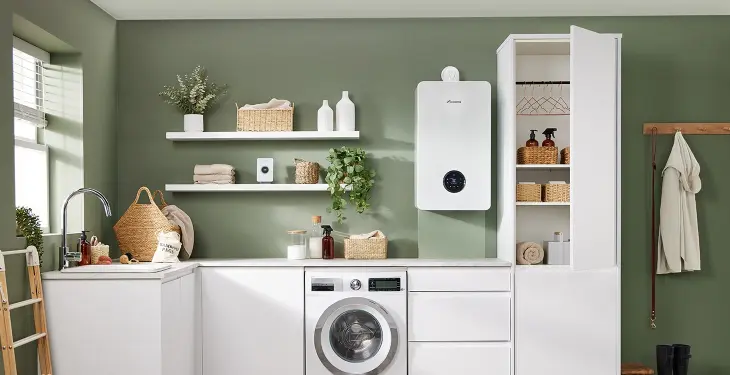

Written by Stephen Day
Gas Safe Engineer
Updated: 16th October, 2025
Heat loss in a home happens when warm air escapes to the outside, and cold air infiltrates. This process can occur through various parts of a house, including walls, roofs, windows, and doors.
Get a new boiler quote, save up to £550 per year (0% APR available).
Understanding how heat is lost from your home is essential for maintaining comfort and saving on energy bills. Many UK households face the challenge of reducing heat loss, especially during the cold months. There's significant potential to improve warmth and efficiency through a few straightforward strategies. One effective method is to insulate the roof and loft, as these areas can account for a quarter of heat loss in uninsulated homes.
Addressing draughts from windows, doors, and unused chimneys can make a noticeable difference in indoor warmth. Investing in quality insulation will not only make the home more comfortable but also contribute to lower energy bills. Identifying where heat escapes can empower homeowners to make informed decisions about improving their home's efficiency.
Each home may experience different heat loss culprits, but with the right approach, it’s possible to greatly enhance energy efficiency. Tackling these issues requires a combination of practical steps, smart investments, and understanding the specific needs of each house.
Get a quote in 60 seconds, fitted as fast as next day!
0% APR finance available.
Heat loss in a home happens when warm air escapes to the outside, and cold air infiltrates. This process can occur through various parts of a house, including walls, roofs, windows, and doors.
Walls and roofs are primary areas where heat escapes. Poor insulation here can lead to significant energy waste. Adding insulation reduces this unwanted heat flow.
Windows and doors also contribute to heat loss. Draughts around these areas let cold air in. Low-energy double glazing can minimise this effect, helping to maintain warmth in the house.
Even small leaks and gaps in the structure can add up to a big issue. Sealing cracks in floors, walls, and around pipework reduces unwanted airflow, making heating more efficient.
Internal factors also play a role. Poor ventilation or an inefficient heating system can exacerbate heat loss by failing to distribute warmth evenly.
Proper understanding of heat loss is crucial. It helps homeowners identify weak points and take effective measures to enhance comfort and reduce energy costs.
Heat loss in a home can have significant impacts. It influences household bills, affects personal comfort levels, and may lead to property damage.
With more heat escaping, energy bills tend to rise. When a house lacks proper insulation, it requires more energy to maintain a warm indoor environment. This means heating systems must operate for longer hours or at higher settings. Homeowners may notice substantial increases in their monthly expenses, especially during colder months. Reducing heat loss through methods like insulation can lower these costs. Additionally, sealing gaps around doors and windows with draught excluders or weather stripping helps prevent unnecessary heat escape. This not only saves money but also conserves energy.
Heat loss can greatly affect the comfort of those living in the house. Rooms might feel colder, creating uncomfortable drafts. If certain areas do not maintain consistent temperatures, people might use portable heaters, increasing energy consumption. Moreover, living in a well-insulated house without drafts can significantly enhance personal comfort. Even distribution of warmth across rooms helps maintain a stable indoor climate. Proper insulation also reduces the impact of external weather changes, making the space more inviting, regardless of the season.
Over time, heat loss can have damaging effects on the property itself. Persistent cold spots can lead to condensation, which may cause dampness and mould growth. This can damage walls, ceilings, and furnishings, requiring costly repairs. In older homes, uninsulated roofs or walls might worsen this problem. Preventative measures such as installing loft and wall insulation or using vapour barriers can protect the property. Furthermore, maintaining a stable indoor temperature supports the longevity of the home's structure, preserving its value.
Heat loss is a common issue in many homes, especially during the colder months. In a typical house, there are several main areas where heat tends to escape.
Roof: The roof is a primary source of heat loss, with approximately 25% of warmth escaping through this area. Proper insulation can help reduce this significantly.
Walls: About 35% of heat is lost through the walls. Insulating cavity walls is an effective way to minimise this escape.
Windows and Doors: Gaps around windows and doors can account for a large portion of heat loss. Ensuring these are well-sealed is crucial to maintaining warmth.
Floors: Around 10% of the home's heat can be lost through the floors. Adding insulation beneath floorboards can help retain heat.
Each of these areas can be improved with insulation and sealing techniques to keep homes warmer for longer, making them more energy-efficient.
Cutting down on heat loss in the home not only saves money but also makes the space more energy-efficient and environmentally friendly. It involves addressing key areas where heat tends to escape and using effective insulation methods.
Cavity wall insulation fills the gaps between the outer and inner walls of a house. This prevents heat from escaping through these spaces. Usually, experts drill holes into the exterior walls and inject insulating material, such as foam or wool, which acts as a barrier to heat loss.
Proper insulation of cavity walls can significantly reduce energy bills and improve warmth. It is especially effective in older homes built with hollow wall spaces. The process generally involves a specialist, ensuring a thorough and proper insulation job that complies with building regulations.
Homes with solid walls often lose more heat since they lack the natural gap found in cavity walls. Insulating these walls can be done either internally or externally. External insulation involves adding a layer to the outside of the building, while internal insulation uses material on the interior side of the walls.
This form of insulation is more expensive but offers substantial energy savings. In addition, external wall insulation can also improve the home's appearance and provide extra weather protection, while internal wall insulation reduces room space slightly but is equally effective at retaining heat.
Heat can also escape through floors, particularly where they are not insulated. In older houses with suspended timber floors, insulation can involve lifting the floorboards and placing insulation, like mineral wool, between the joists.
For concrete floors, a rigid insulation layer is laid on top. This method is straightforward for ground floors and can lead to noticeable warmth and reduced heating costs. Proper floor insulation ensures a comfortable atmosphere and can be a worthwhile long-term investment for improving energy efficiency.
The roof and loft are primary regions for heat loss, with warm air rising and escaping through the tops of buildings. Loft insulation is a cost-effective way to reduce this heat loss. This involves laying insulation material such as fibreglass or wool over the floor of the loft or between the roof rafters.
Maintaining proper insulation thickness is crucial as it substantially decreases energy consumption. This measure is relatively easy to install, offering a quick improvement in home comfort and energy efficiency.
Draught proofing involves sealing unwanted gaps through which cold air sneaks in and warm air leaks out. Common places include windows, doors, and chimneys. Maintaining a warm home starts with covering these gaps using draught excluders, sealants, and weatherstripping.
It is an affordable and straightforward measure with immediate effects on reducing heat loss. Custom solutions are available for different types of windows and doors, ensuring no area is left susceptible to draughts, thereby improving heating efficiency.
Windows and doors are significant points of heat loss. Double or triple glazing provides a much better barrier than single glazing by trapping air between panes, reducing heat transfer. Secondary glazing is also an option for historic or listed buildings.
Additionally, sealing around window frames and installing insulated doors help prevent heat from escaping. Choosing the right glazing and ensuring proper installation leads to improved thermal performance, adding to overall energy efficiency and reducing heating demands.
Insulating hot water tanks, pipes, and radiators ensures that the heat generated remains in the system rather than being lost to the surrounding air. An insulating jacket around a hot water cylinder retains heat, making water heating more efficient and faster.
Pipe insulation is conducted using foam tubing, which prevents heat loss along the system. Radiator reflectors positioned behind radiators direct heat back into rooms rather than losing it to walls. These simple measures make a significant difference in both comfort and energy savings.
Modern gas boilers are designed with high efficiency in mind. They utilize most of the fuel they consume, meaning less energy is lost as waste. In fact, many modern boilers achieve efficiency ratings of up to 98.5%. This means only a small portion of energy escapes unused.
These boilers often incorporate condensing technology. This allows them to recover heat from the condensation produced during operation, further boosting their efficiency. Condensing boilers have been a standard requirement since 2005, ensuring that new installations meet high efficiency standards.
Government regulations, like the Boiler Plus rules of 2018, mandate that all new gas boiler installations in the UK must have an efficiency rating of at least 92%. In addition to being energy efficient, boilers must also include controls for time and temperature, which help in reducing energy usage even further.
Cost savings play an important role here as well. While the initial price for a new high-efficiency boiler might seem steep, the reduction in heating bills over time can make it a worthwhile investment. Individuals seeking to upgrade should consider consulting a professional to explore suitable options for their homes.
Table: Efficiency Features
Feature | Benefit |
Condensing Technology | Recovers heat, increases efficiency |
Minimum 92% Efficiency | Meets regulatory standards |
Time & Temperature Controls | Optimizes energy usage and comfort |
By choosing a modern gas boiler that embodies these features, homeowners can significantly reduce both their energy bills and their carbon footprint.
Get a quote in 60 seconds, fitted as fast as next day!
0% APR finance available.
Last updated: 16th October, 2025

Written by Stephen Day
Gas Safe Engineer at iHeat
Stephen Day is a Gas Safe registered and FGAS certified engineer with over 20 years of hands-on experience in the heating, cooling, and renewable energy industry, specialising in boiler installations, air conditioning, and heat pump systems.
LinkedInArticles by Stephen Day are reviewed by iHeat’s technical team to ensure accuracy and reliability.

12th December, 2025
The best electric combi boilers in 2025 include models from Electric Heating Company, Heat...
 Read Article
Read Article

12th December, 2025
The Vaillant F22 fault means your boiler pressure is too low and needs topping up.
 Read Article
Read Article

12th December, 2025
A combi boiler should be around 1.0 to 1.5 bar when cold and up to about 2.0 bar when hot.
 Read Article
Read Article
No obligation. Takes less than 60 seconds.